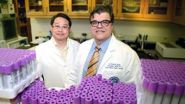(Press-News.org) Teamwork has been fundamental in humanity's greatest achievements but scientists have found that working together has its evolutionary roots in our nearest primate relatives – chimpanzees.
A series of trials by scientists found that chimpanzees not only coordinate actions with each other but also understand the need to help a partner perform their role to achieve a common goal.
Pairs of chimpanzees were given tools to get grapes out of a box. They had to work together with a tool each to get the food out. Scientists found that the chimpanzees would solve the problem together, even swapping tools, to pull the food out.
The study, published in Biology Letters, by scientists from Warwick Business School, UK, and the Max Planck Institute for Evolutionary Anthropology in Leipzig, Germany, sought to find out if there were any evolutionary roots to humans' ability to cooperate and coordinate actions.
Dr Alicia Melis, Assistant Professor of Behavioural Science at Warwick Business School, said: "We want to find out where humans' ability to cooperate and work together has come from and whether it is unique to us.
"Many animal species cooperate to achieve mutually beneficial goals like defending their territories or hunting prey. However, the level of intentional coordination underlying these group actions is often unclear, and success could be due to independent but simultaneous actions towards the same goal.
"This study provides the first evidence that one of our closest primate relatives, the chimpanzees, not only intentionally coordinate actions with each other but that they even understand the necessity to help a partner performing her role in order to achieve the common goal.
"These are skills shared by both chimpanzees and humans, so such skills may have been present in their common ancestor before humans evolved their own complex forms of collaboration"
The study, revealed in a paper entitled Chimpanzees' (Pan troglodytes) strategic helping in a collaborative task, looked at 12 chimpanzees at Sweetwaters Chimpanzee Sanctuary in Kenya, which provides lifelong refuge to orphaned chimpanzees, who have been illegally traded as pets or saved from the 'bushmeat' trade.
The chimpanzees were put into pairs, with one needed at the back and one at the front of a sealed plastic box. Through a hole the chimpanzee at the back had to push the grapes onto a platform using a rake. The chimpanzee at the front then had to use a thick stick and push it through a hole to tilt the platform so the grapes would fall to the floor and both could pick them up to eat.
One chimpanzee was handed both tools and they had to decide which tool to pass to the partner. Ten out of 12 individuals solved the task figuring out that they had to give one of the tools to their partner and in 73 per cent of the trials the chimpanzees chose the correct tool.
Dr Melis said: "There were great individual differences regarding how quickly they started transferring tools to their partner. However, after transferring a tool once, they subsequently transferred tools in 97 per cent of the trials and successfully worked together to get the grapes in 86 per cent of the trials.
"This study provides the first evidence that chimpanzees can pay attention to the partner's actions in a collaborative task, and shows they know their partner not only has to be there but perform a specific role if they are to succeed. It shows they can work strategically together just like humans do, working out that they not only need to work together but what roles each chimpanzee has to do in order to succeed.
"Although chimpanzees are generally very competitive when trying to gain access to food and would rather work alone and monopolize all the food rewards, this study shows that they are willing and able to strategically support the partner performing their role when their own success is dependent on the partner's."
###
NB: This study was approved by the local ethics committee at Sweetwater Sanctuary and relevant authorities in Kenya. The chimpanzees were never deprived of food and water was available at all times. They could choose to stop participating at any time.
Notes to editors
To interview Dr Alicia Melis contact her at Alicia.Melis@wbs.ac.uk, 024-765-24498.
For more information contact:
Ashley Potter, Press & PR Officer, Warwick Business School
Tel: 44-0-24-7657-3967
Mob: 44-0-7733-013264
Email: Ashley.potter@wbs.ac.uk END
The realisation of quantum networks is one of the major challenges of modern physics. Now, new research shows how high-quality photons can be generated from 'solid-state' chips, bringing us closer to the quantum 'internet'.
The number of transistors on a microprocessor continues to double every two years, amazingly holding firm to a prediction by Intel co-founder Gordon Moore almost 50 years ago.
If this is to continue, conceptual and technical advances harnessing the power of quantum mechanics in microchips will need to be investigated within the next decade. Developing ...
Better diagnosis and treatment of cancer could hinge on the ability to better understand a single cell at its molecular level. New research offers a more comprehensive way of analyzing one cell's unique behavior, using an array of colors to show patterns that could indicate why a cell will or won't become cancerous.
A University of Washington team has developed a new method for color-coding cells that allows them to illuminate 100 biomarkers, a ten-time increase from the current research standard, to help analyze individual cells from cultures or tissue biopsies. The ...
Three-quarters of the DNA in evolved organisms is wrapped around proteins, forming the basic unit of DNA packaging called nucleosomes, like a thread around a spool. The problem lies in understanding how DNA can then be read by such proteins. Now, Arman Fathizadeh, a physicist at Sharif University of Technology in Tehran, Iran, and colleagues have created a model showing how proteins move along DNA, in a paper just published in EPJ E.
The problem is that until now, we did not clearly understand the physical mechanisms of how to "open the book" to read the genetic text ...
AUGUSTA, Ga. – A group of tiny RNA molecules with a big role in regulating gene expression also appear to have a role in causing insulin resistance in woman with polycystic ovary syndrome and, perhaps, in all women, researchers report.
Research in the journal Diabetes, indicates that high activity levels of a microRNA called miR-93 in fat cells impedes insulin's use of glucose, contributing to PCOS as well as insulin resistance, said Dr. Ricardo Azziz, reproductive endocrinologist and PCOS expert at the Medical College of Georgia at Georgia Regents University.
"This ...
Researchers at the University of Southampton's Optoelectronics Research Centre (ORC) have created an artificial material, a metamaterial, with optical properties that can be controlled by electric signals.
Photonic metamaterials are artificial materials created by precise and extremely fine structuring of conventional media using nanotechnology. They offer numerous new applications from cloaking to radically improved solar cells. However, the properties of metamaterials are usually fixed.
Dr Eric Plum, Research Lecturer at the ORC, explains: "We have found a fast ...
CHICAGO – High-energy lower-extremity trauma (HELET) is common in modern warfare, often resulting in severe tissue damage, chronic pain, neurovascular injury and significant muscle loss, according to the new research presented today at the 2013 Annual Meeting of the American Academy of Orthopaedic Surgeons (AAOS).
The Return to Run (RTR) program is an integrated orthotic and rehabilitation initiative designed to return high-level function to wounded warriors. It includes use of the new Intrepid Dynamic Exoskeletal Orthosis (IDEO), a custom-fit device made from carbon ...
Milan, 19 March 2013 - The initial study results of the Zometa European Study (ZEUS) showed no difference in the incidence of bone metastases between the Zometa group and control arm, said Prof. Manfred Wirth during the closing and fourth plenary session of the 28th Annual EAU Congress which ends today.
"There is no difference in the incidence of bone metastases and there is no difference in survival," said Wirth in his brief presentation on whether Zometa can prevent bone metastases in high risk, metastatic prostate cancer patients. The ZEUS study, supported by the EAU ...
The phenomenon of adoption has taxed the minds of evolutionary scientists since Darwin first came up with his account of natural selection. According to Richard Dawkins's description, adoption is "a double whammy. Not only do you reduce, or at least fail to increase, your own reproductive success, but you improve someone else's." So why are animals apparently so willing to take care of young that are not related to them?
Franziska Schaedelin and colleagues at the Konrad Lorenz Institute of the University of Veterinary Medicine, Vienna now shed interesting light on the ...
Milan, 19 March 2013 – Patients with benign prostatic hyperplasia (BPH) carrying prostate cancer (PCa) a risk alleles are a potential target population for PCa screening and follow-up, according to a study, which was presented yesterday at the 28th Annual EAU Congress in Milan.
The study aimed to evaluate the genetic predisposition of patients with BPH to developing prostate cancer, with findings suggesting that genetic testing may offer a new tool to identify BPH patients with increased risk to develop PrCa.
"To our knowledge this is the first study to evaluate genetic ...
This retrospective multicenter study, which included 677 patients from 6 centres, aimed to evaluate intraoperative, early postoperative and mesh-related complications for surgical management of female pelvic organ prolapse (POP) with application of trocar guided transvaginal synthetic mesh.
In the course of the study the patients underwent POP surgery from 2006 to 2010. The patients were operated for symptomatic genital prolapse POP-Q stage 2 to 4. Patients were systematically seen within 1 and 3 months and then evaluated again during the study via phone interview and ...


